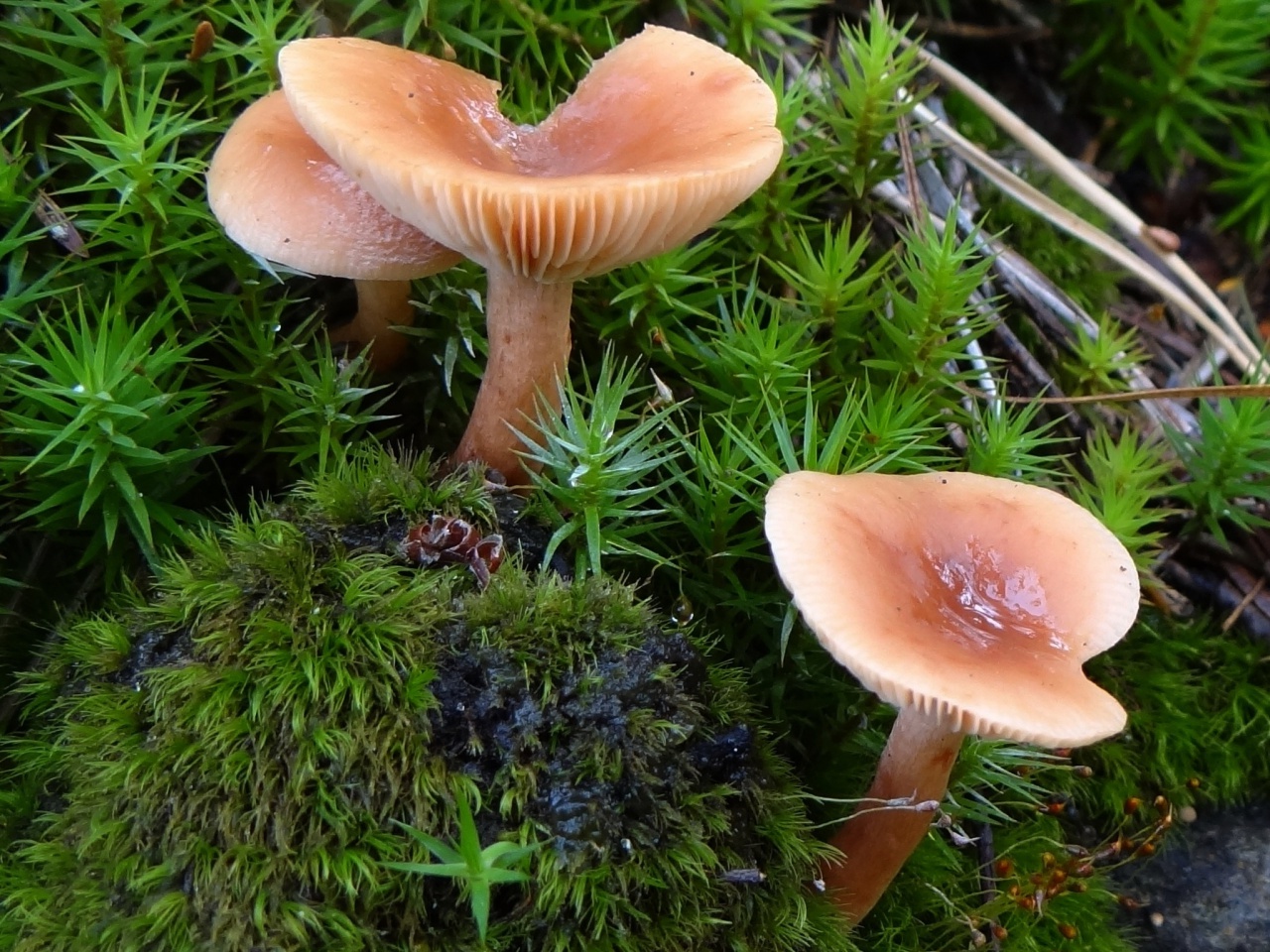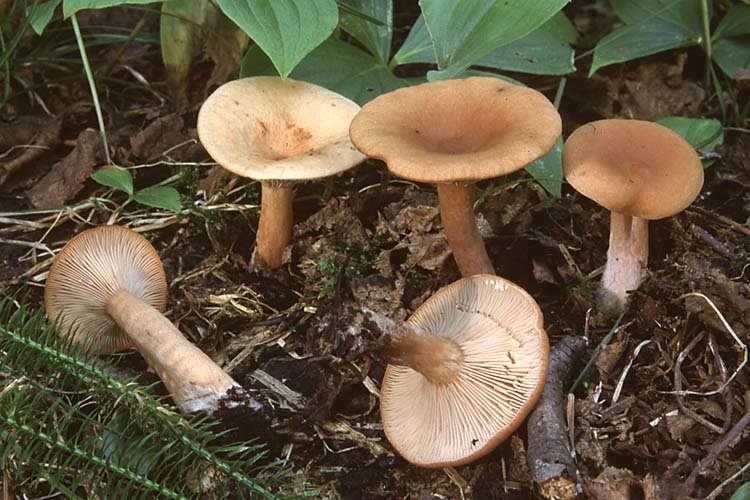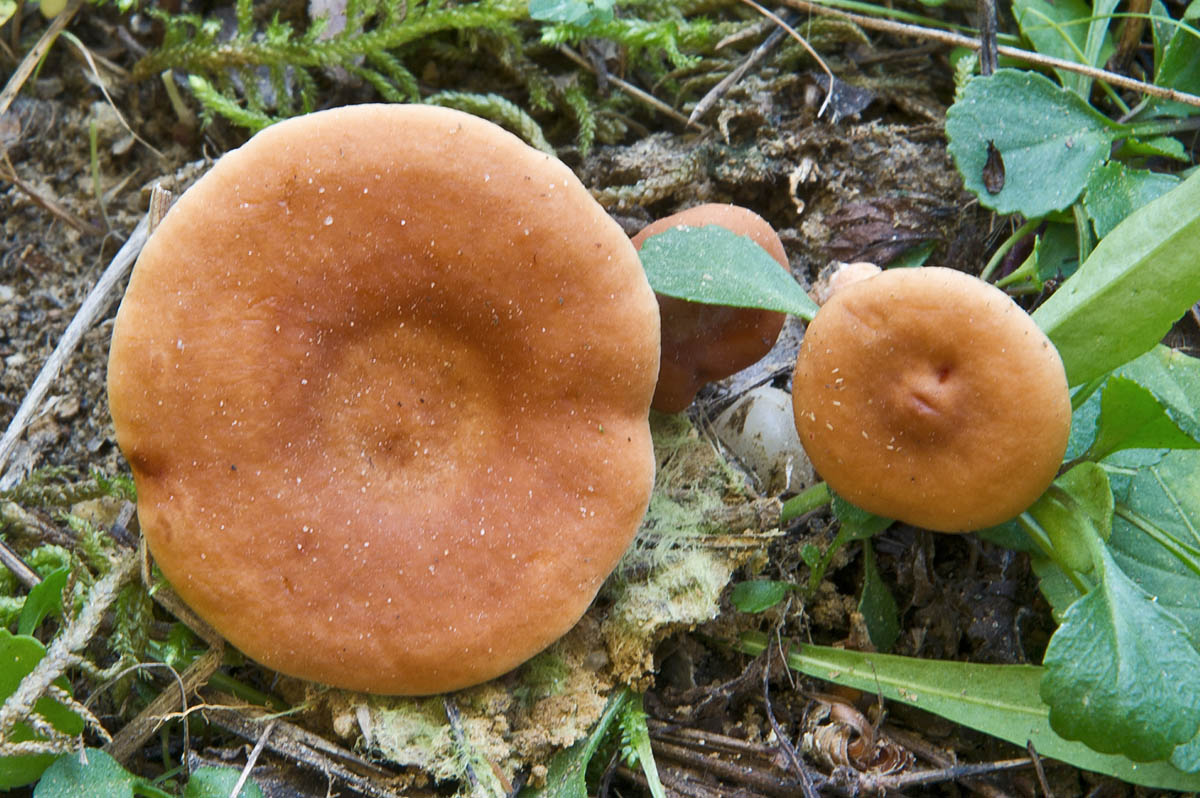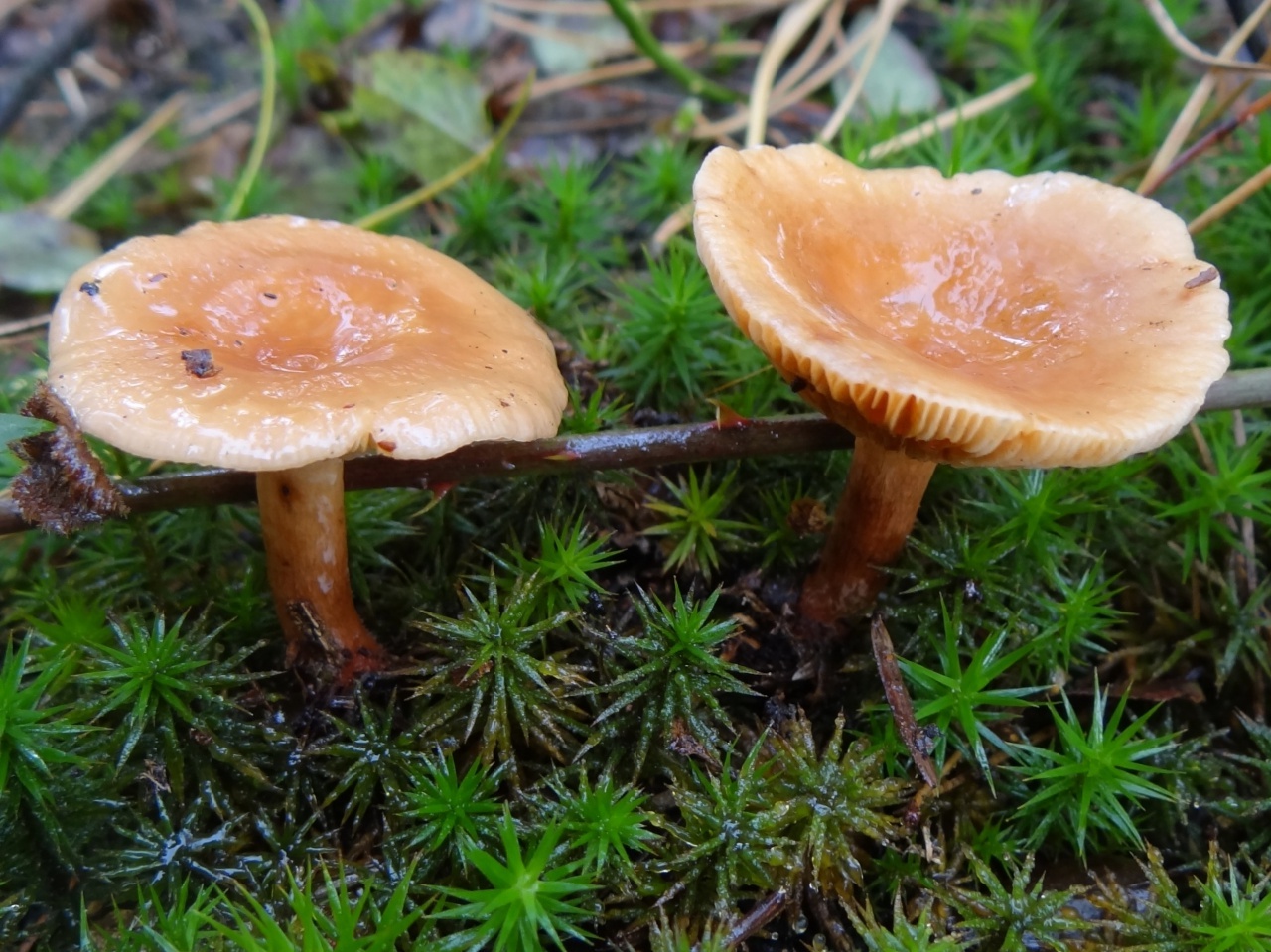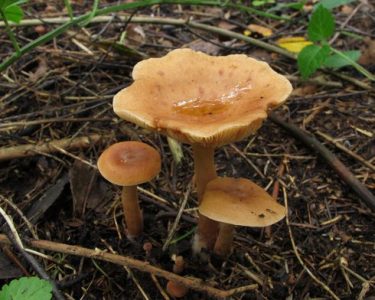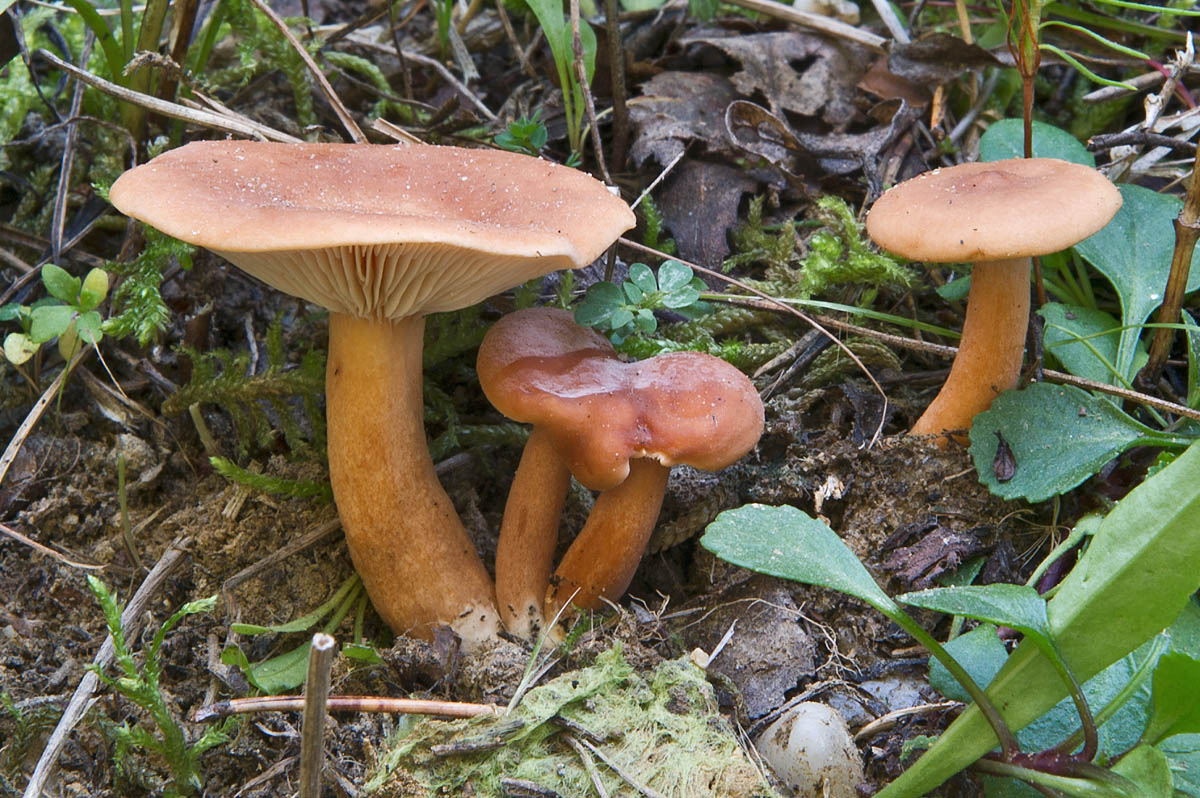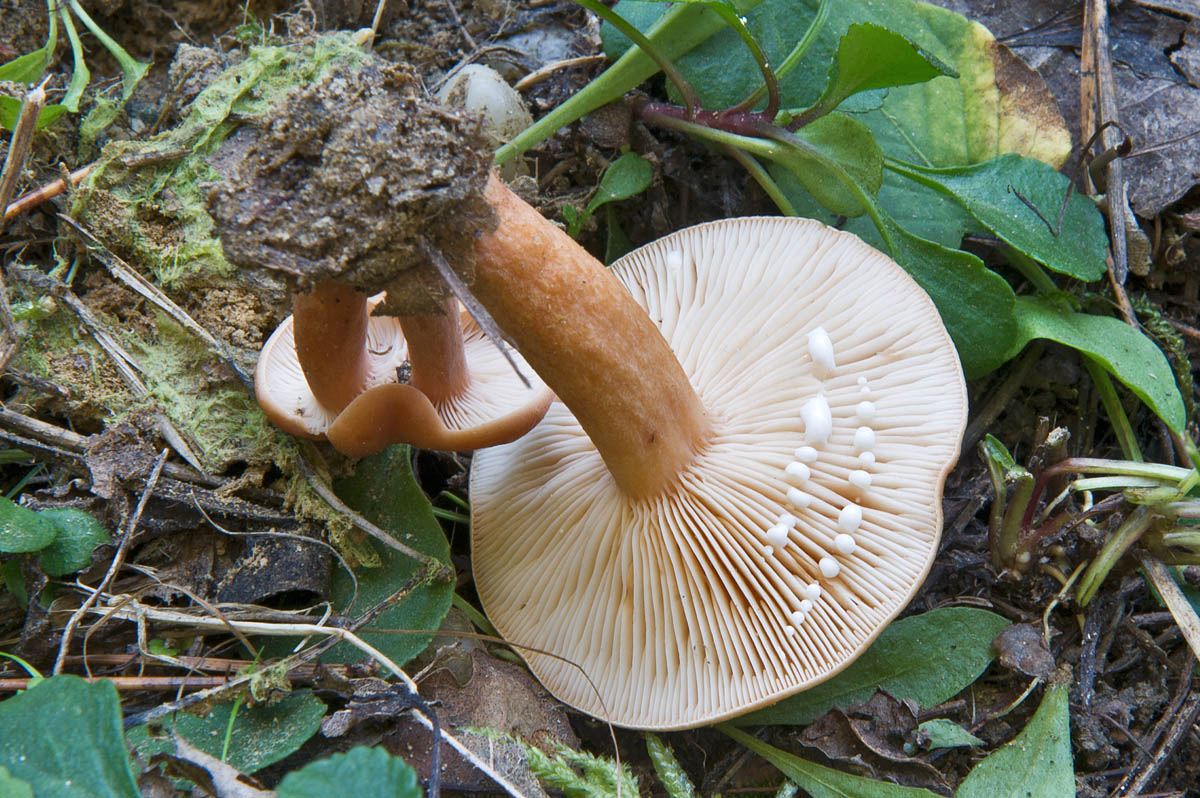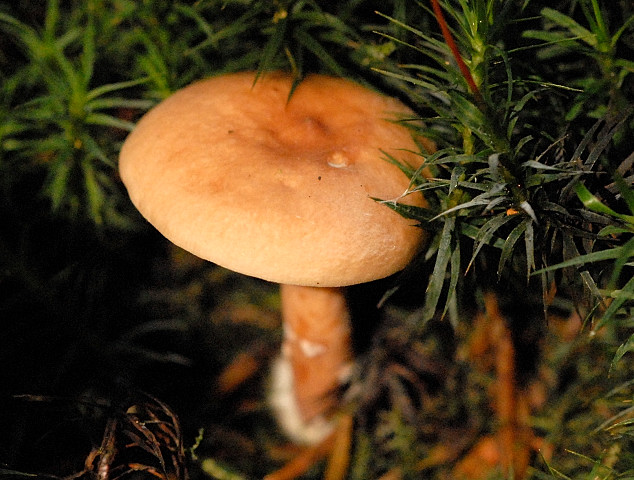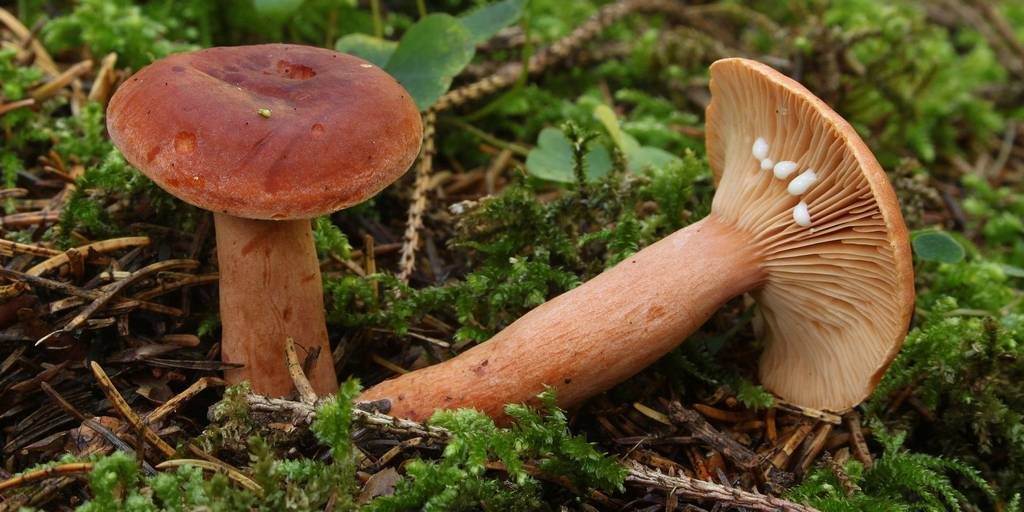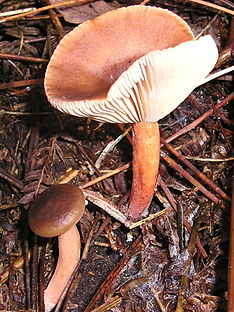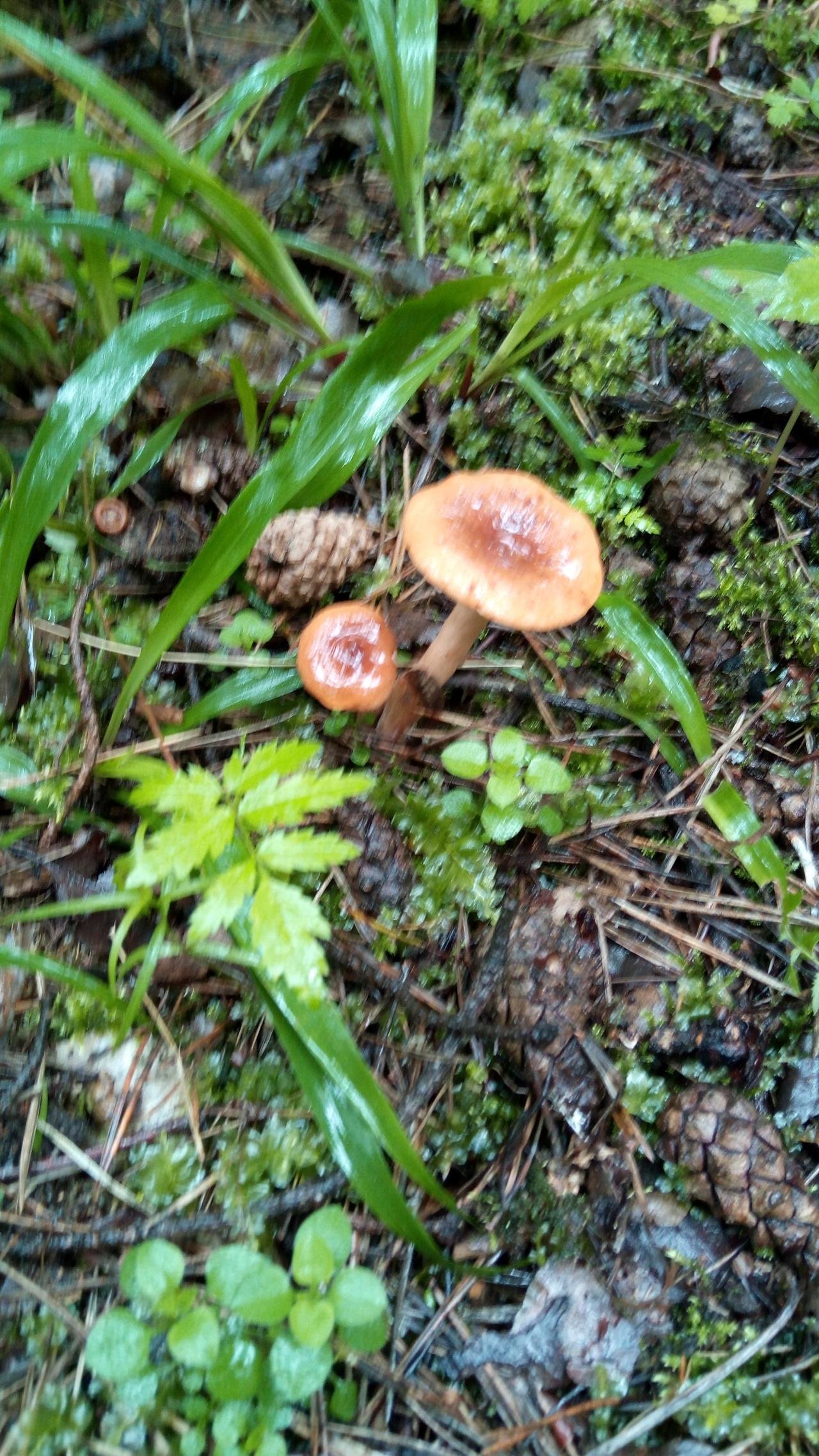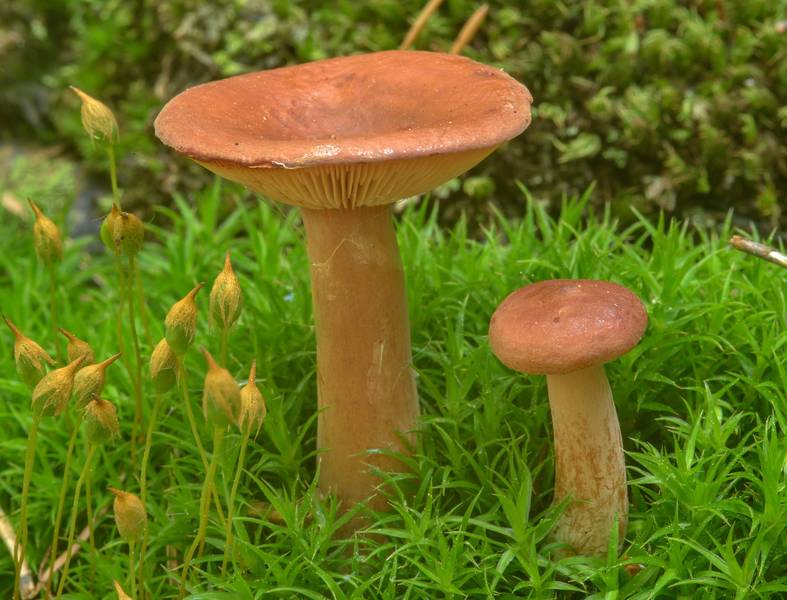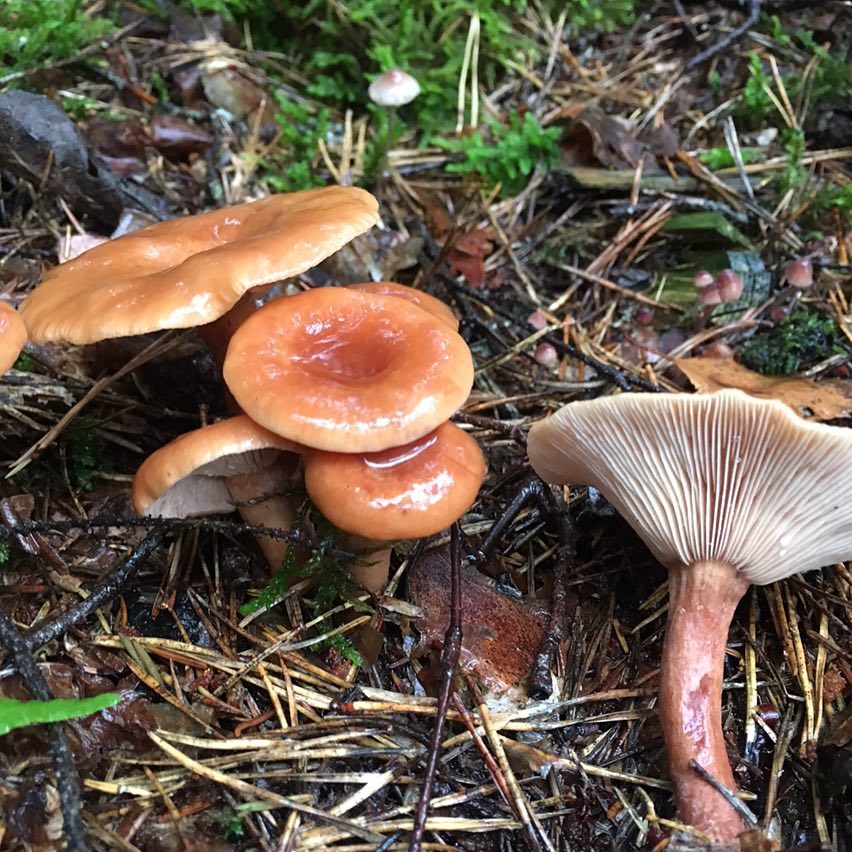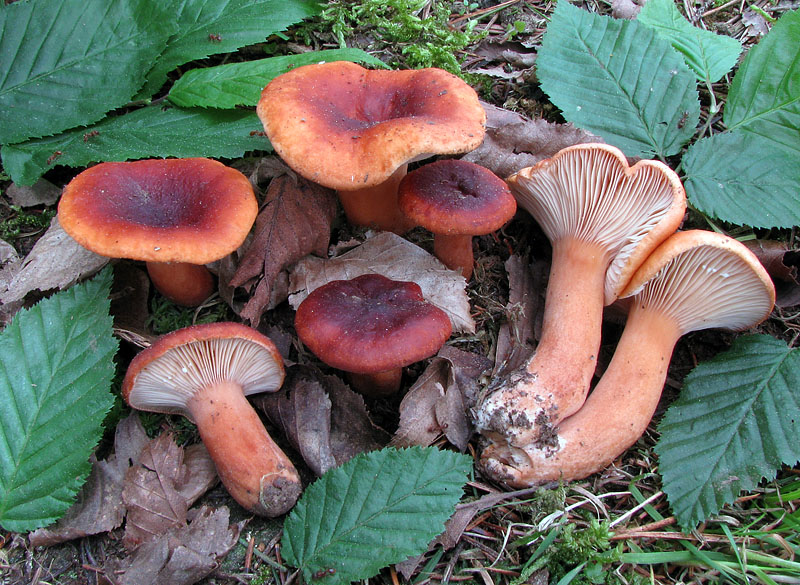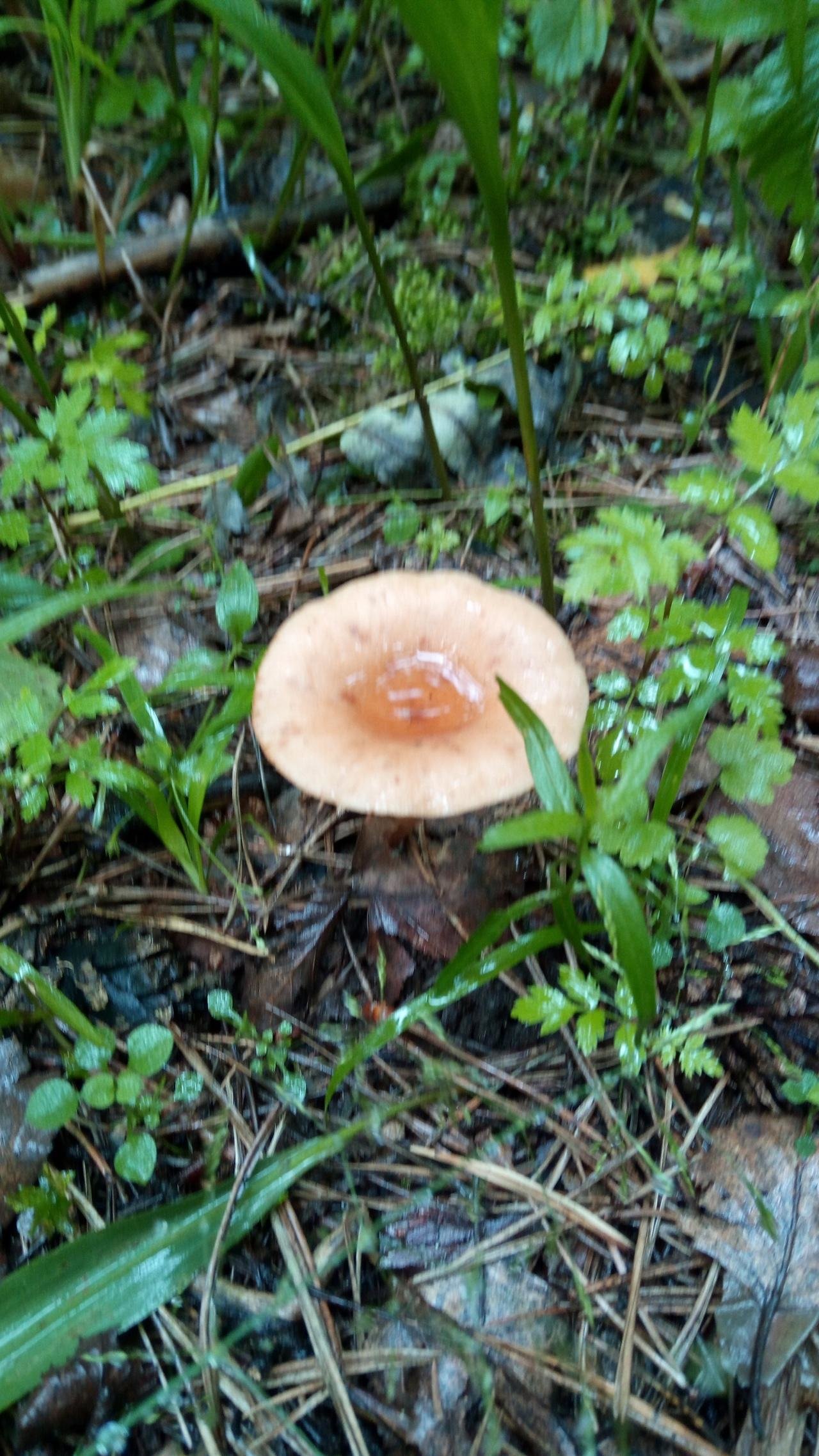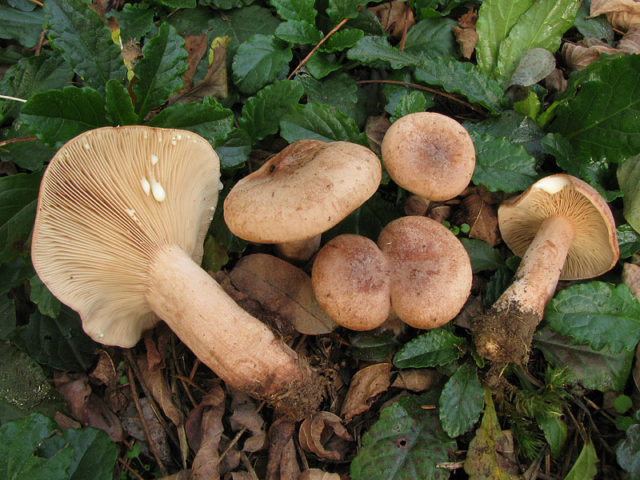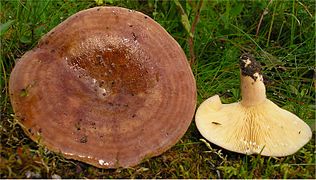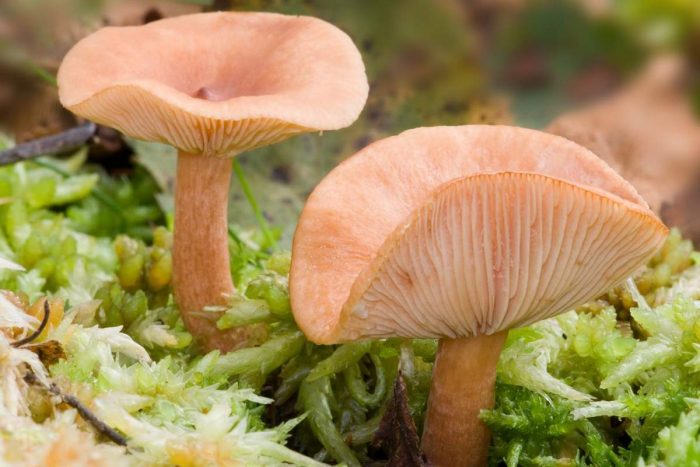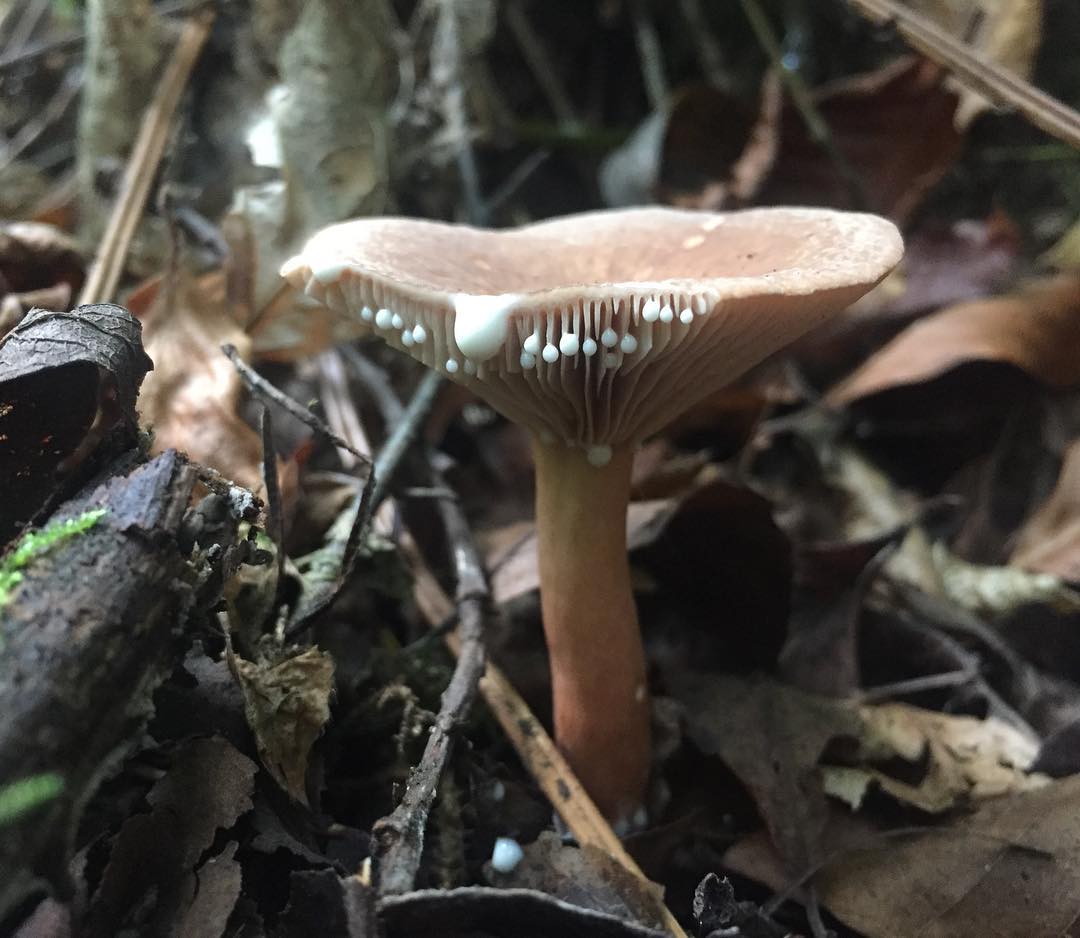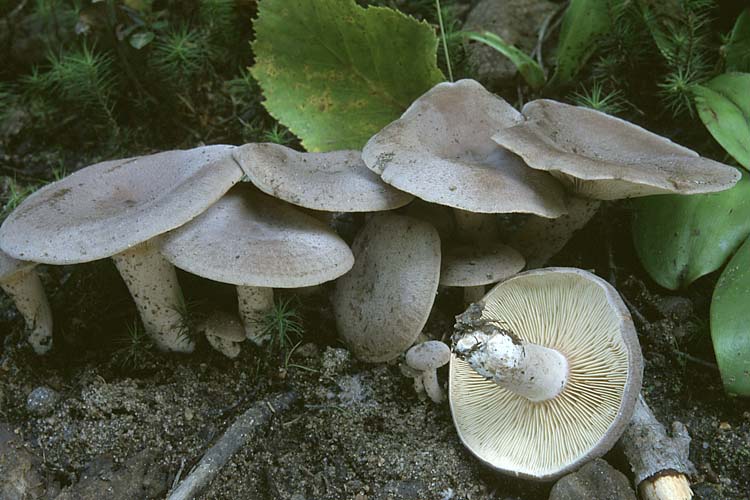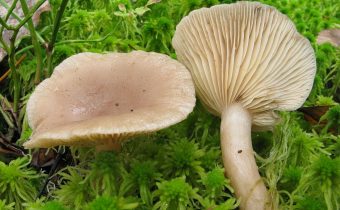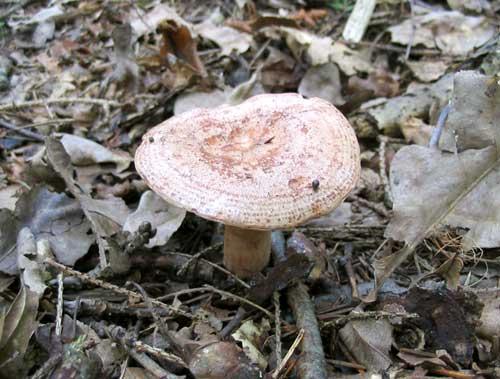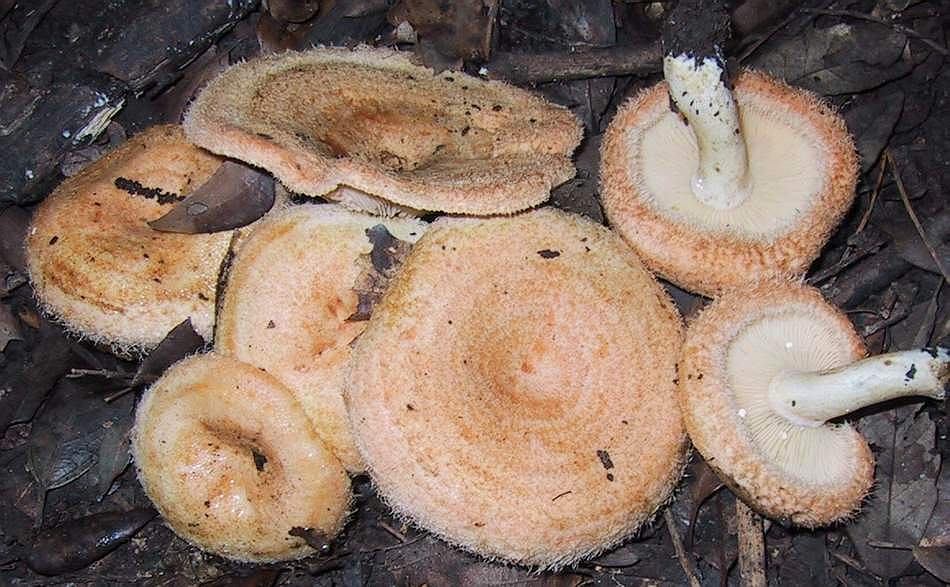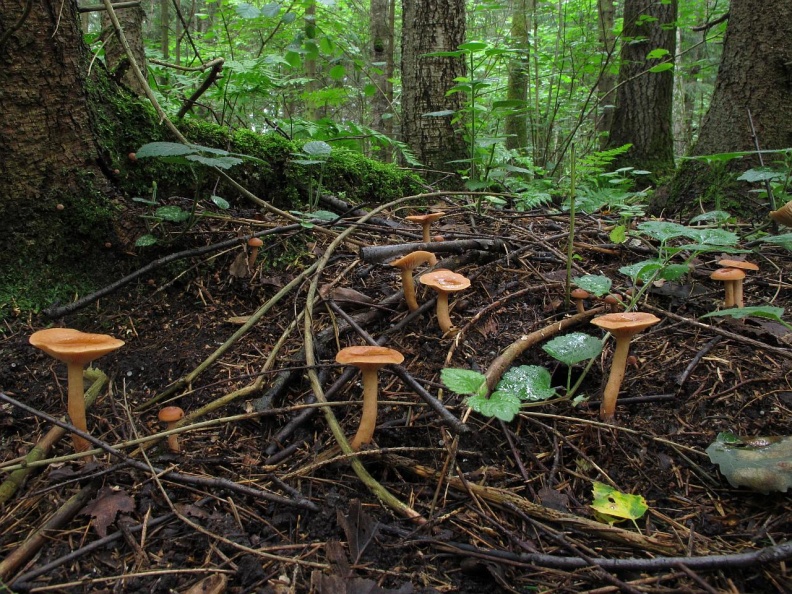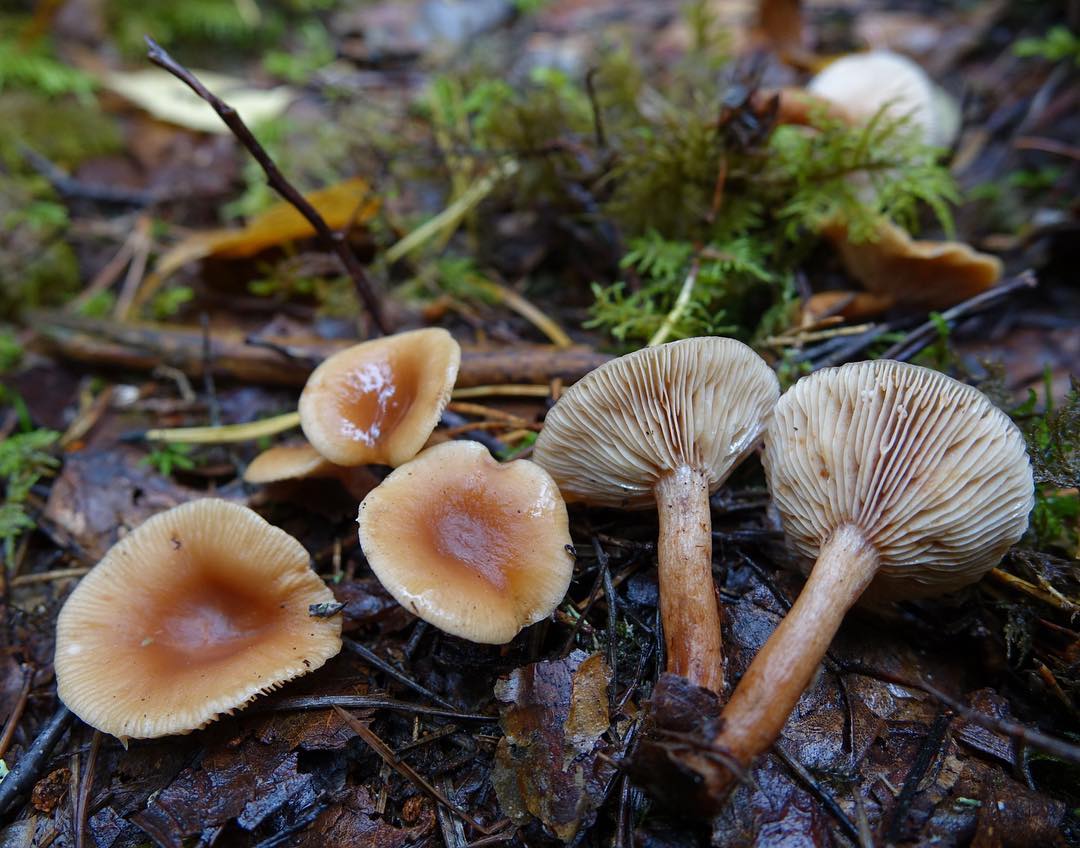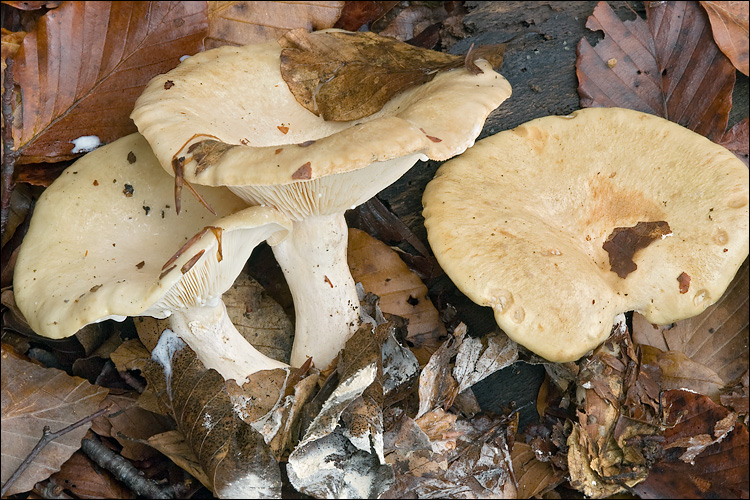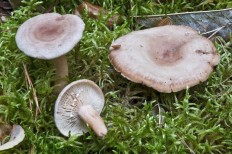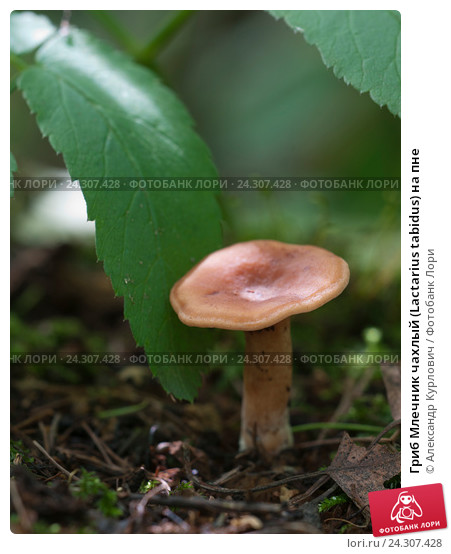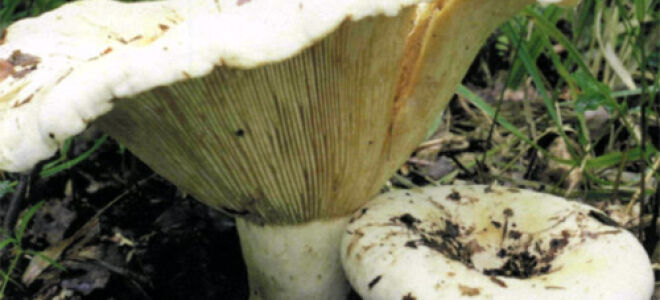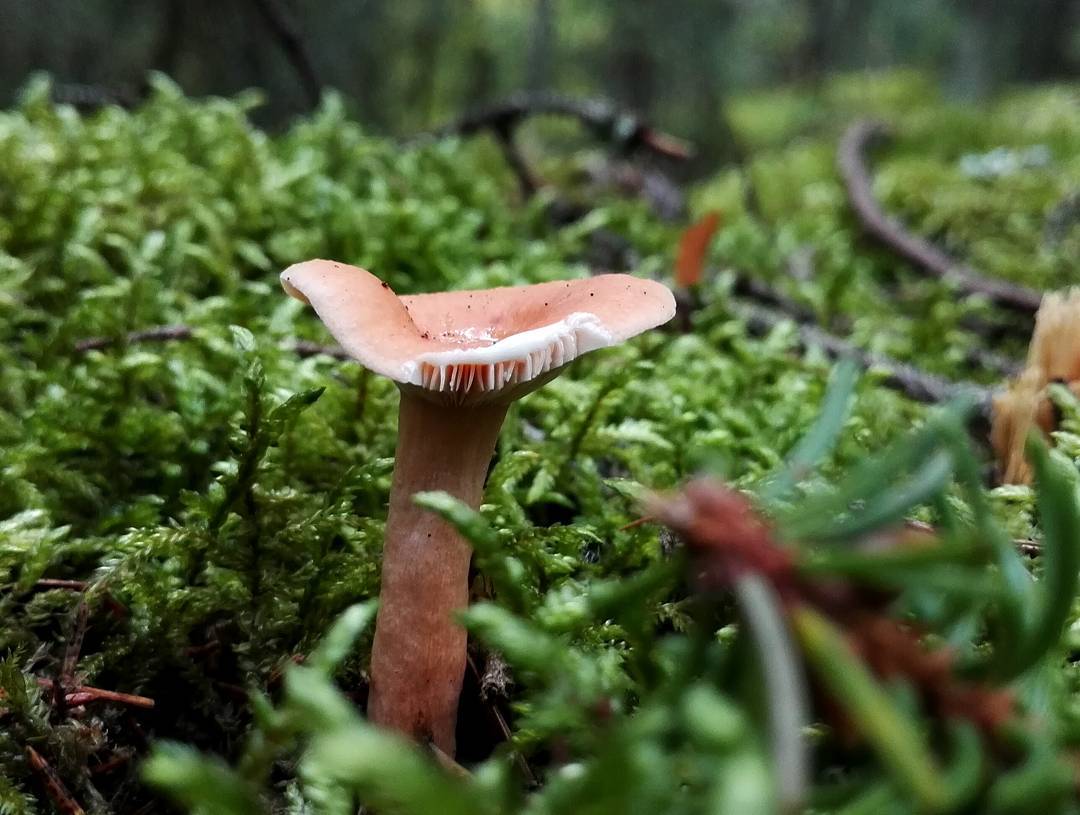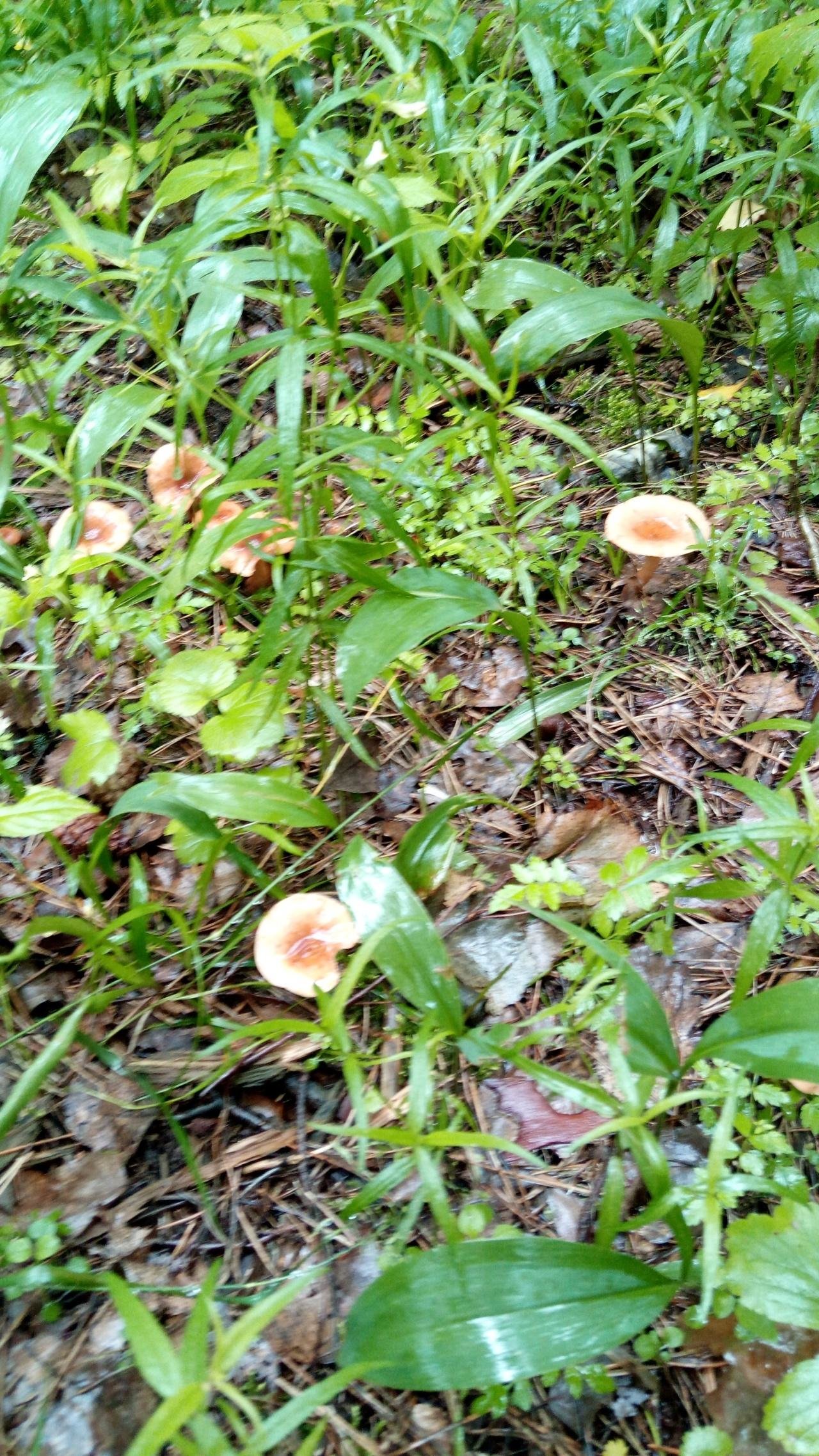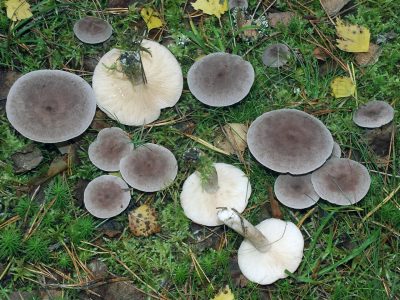Gray-pink Miller (Lactarius helvus)
Synonyms:
Gray-pink miller (lat.Lactarius helvus) is a mushroom of the genus Miller (lat.Lactarius) of the russula family (lat.Russulaceae). Conditionally edible.
Gray-pink milky's hat:
Large (8-15 cm in diameter), more or less rounded, equally prone to both the formation of a central tubercle and a depression; with age, these two signs can appear at the same time - a funnel with a neat bump in the middle. The edges in youth are neatly tucked up, gradually roll out as they mature. Color - hard to describe, dull grayish brownish pink; the surface is dry, velvety, not prone to hygrophilousness, does not contain any concentric rings. The pulp is thick, brittle, whitish, with a very strong spicy odor and a bitter, not particularly pungent taste. Milky sap is scanty, watery, in adult specimens it may be completely absent.
Plates:
Weakly descending, medium frequency, the same scale as the hat, but somewhat lighter.
Spore powder:
Yellowish.
Gray-pink lactarius leg:
Quite thick and short, 5-8 cm in height (in mosses, however, it can be much longer), 1-2 cm in thickness, smooth, gray-pinkish, lighter than the cap, in youth, solid, strong, forms uneven lacunae.
Spreading:
The gray-pink miller is found in bogs among birches and pines, in mosses, from early August to mid-October; in late August-early September, it can, under favorable circumstances, bear fruit in huge quantities.
Similar species:
The smell (spicy, not very pleasant, at least not for everyone - I don't like it) allows you to distinguish the gray-pink milky from other similar mushrooms with complete confidence. For those who are just starting to get acquainted with the milkmen, relying on literature, we will say that another relatively similar mushroom with a strong smelling pulp, the oak milkman Lactarius quietus grows in dry places under oak trees, is much smaller and, on the whole, is not at all similar.
Edibility:
In foreign literature, it is listed as weakly poisonous; here it is referred to as inedible or as edible, but of little value. People say that if you are willing to put up with the smell, then you get a milkman like a milkman. When it appears in the absence of valuable commercial mushrooms, it is at least interesting.
Remarks An enthusiast of mushroom pleasures is always uncomfortable to admit such things, but Lactarius helvus became one of the few milkmen who made a brightly inedible impression on me. A large, weighty mushroom with an unpleasantly dry cap, not affected by either a worm or a slug, for some reason does not fit into the basket. Perhaps it's a suspicious smell; if it were even a little weaker, it could be called piquant, spicy, or just like a chemical weapon. As with many other common mushrooms growing in pines, I met the gray-pink lactarius very late, at a conscious mushroom age; met and under the first pretext that came across, interrupted the acquaintance. Something is wrong here. Something the same as that of the oak milkman. It seems like a mushroom of a noble family and a valiant article, and not happy. Or the problem is no longer even in the mushroom ...
Common Miller (Lactarius trivialis)
Synonyms:
Milker's Hat:
Quite large, 7-15 cm in diameter, in young mushrooms of a compact "wheel-like" shape, with strongly tucked, non-pubescent edges and a depression in the center; then it gradually opens, going through all the stages, up to the funnel-shaped. The color is changeable, from brown (in young mushrooms) or lead-gray to light gray, almost lilac, or even lilac. Concentric circles are weak, mainly at an early stage of development; the surface is smooth, in wet weather it easily becomes slimy, sticky.The flesh of the cap is yellowish, thick, brittle; milky juice is white, acrid, not very plentiful, slightly green in the air. The smell is practically absent.
Plates:
Pale cream, slightly descending, rather frequent; with age, they can become covered with yellowish spots from leaked milky juice.
Spore powder:
Light yellow.
Milky foot:
Cylindrical, of very different heights, depending on the growing conditions (from 5 to 15 cm, if only, as they say, “to the ground”), 1-3 cm thick, similar in color to a hat, but lighter. Already in young mushrooms, a characteristic cavity is formed in the stem, quite neat, which only expands as it grows.
Spreading:
The common miller is found from mid-July to the end of September in forests of various types, forming mycorrhiza, apparently with birch, spruce or pine; prefers wet mossy places where it can appear in significant quantities.
Similar species:
Despite the richness of the color range, the common milky mushroom is quite recognizable: the growing conditions do not allow it to be confused with the silver gray (Lactarius flexuosus), and the large size, color constancy (slightly green milky juice does not count) and the absence of a strong odor distinguish Lactarius trivialis from many small milkmen, lilac and exuding unexpected aromas.
Edibility:
The northerners consider it a very decent edible mushroom, we somehow less known, albeit in vain: it ferments in salted faster than its "hard-fleshed" relatives, very soon acquiring that indescribable sour taste for which people deify Russian salting.
Remarks
Lactarius trivialis is a completely unusual mushroom for me. Where I got acquainted with mushrooms, he was not. And where I visited from time to time, he was not there either. Only occasionally, little by little, did the common milkman appear to me in mosses, in swamps with crooked pines, in feeble birch forests and in grassy glades. Once I took half a basket of it, picked it up and salted it. It seems that the rumor is not lying: the mushroom is really excellent. I really look forward to renewing my acquaintance as early as next year, that's why I don't write here everything that I know and think. There will still be a reason.
Chemical composition
The smoothie is 90% water, which evaporates during cooking. Also, the composition of the lactic acid contains proteins that are concentrated in the caps. Found the presence of the most important amino acids: leucine, tyrosine, histidine, arginine.
Did you know? During the growth period, the mushroom hat can break through marble and granite. If she fails to pass through the minerals, then the micelle will overcome the obstacles.
The composition of the mushroom includes vitamins of group B, PP, D, in small quantities - A and C. In the smooth, there is a high concentration of phosphorus and potassium. Copper, zinc and manganese are found.
Miller, like any mushroom, contains chitin. This substance is difficult for the human body to absorb, so it is not recommended to abuse large portions of the smoothie.
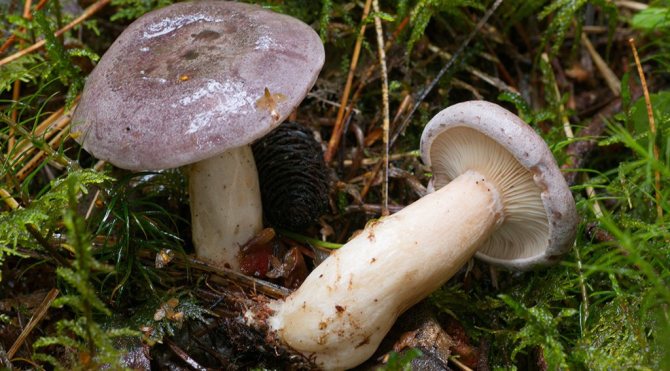
Aromatic substances enhance the taste of the mushroom, and pigments determine its color.
Red-brown Milk (Lactarius volemus)
Synonyms:
- Galorrheus volemus
- Lactifluus volemus
- Amanita lactiflua
- Lactarius lactifluus
- Lactifluus oedematopus
- Lactarius oedematopus
- Lactarius ichoratus
- Galorrheus ichoratus
- Lactifluus ichoratus
- Lactarius testaceus
- Millechnik is the best (by the way, the official Russian-language mycological name)
- Podoreshnik (Belarusian - Padareshnik)
Lactarius volemus (Fr.) Fr., Epicr. syst. mycol. (Upsaliae): 344 (1838)
Description
A hat with a diameter of 5-17 (up to 16) cm, convex in youth, then prostrate, possibly pressed in the center, and even up to concave. The edge of the cap is straight, thin, sharp, first tucked up, then straightened and even raised. The color is reddish-brown, brownish-brown, in rare cases, rusty or light buffy. The surface is velvety at first, then smooth and dry. Often cracked, especially in dry conditions. There is no zonal coloration.
Flesh: White, yellowish, very fleshy and firm. The smell is described in various ways, mainly as a herring (trimethylamine) smell that increases with age, but there are more interesting associations, for example with pear flowers, or not at all. The taste is soft, pleasant, sweetish.
The plates are frequent, from adherent to weakly descending, creamy or warm skin shades, often forked at the leg. There are shortened plates (plates).
Milky sap is abundant, white, turning brown and thickening in the air. For this reason, this type of lactarius turns brown and everything else if damaged - pulp, plates.
The leg is 5-8 (up to 10) cm high, (1) 1.5-3 cm in diameter, hard, often full, the color of the cap, but slightly paler, smooth, may be covered with fine pubescence, which looks like frostiness, but not to the touch felt. Often tapered to the bottom.
The spore powder is white. The spores are close to spherical, according to the data 8.5-9 x 8 µm, 9-11 x 8.5-10.5 µm each. The ornamentation is ridged, up to 0.5 µm in height, forming an almost complete network.
Habitat
Occurs from July to October. One of the earliest milkmen. Grows in deciduous, mixed and spruce forests (in general, in all forests). According to the data, it forms mycorrhiza with oak (Quercus L.), common hazel (Corylus avellana L.) and spruce (Picea A. Dietr.).
Similar species
Given the "power" of this mushroom and the abundant brownish sweetish milky juice, perhaps, it has no similar species. The most similar lactic to him, perhaps, is the hygrophoroid lactarius - Lactarius hygrophoroides, but it is easily distinguished by non-brown milky juice and rare plates. Quite conditionally, rubella (Lactarius subdulcis) can be attributed to similar species, but it is thin-fleshed and slender. The same applies to the orange lactarius (Lactarius aurantiacus = L. mitissimus), it is not only small and thin, but also late, does not overlap in terms, although it grows in exactly the same biotopes with spruce.
Edibility
An edible mushroom that can be eaten raw. It is good in raw salted or pickled form, without any heat treatment. I don't like it in another form because of the "wooden" pulp, although, they say, mushroom caviar is good from it. I hunt him specifically and purposefully, for the sake of raw salting.
Literature Used 1) Verbeken, A. & Vesterholt, J. 2008. Lactarius. - In: Knudsen, H. & Vesterholt, J. (eds.): Funga Nordica, 82-107.2) Flora of Belarus. Mushrooms. In 7 volumes. Volume 1. O.S. Gapienko, Ya.A. Shaporova, 2012, Boletales. Amanitales. Russulales.
Video about the miller mushroom:
Characteristics of the milky mushroom
Hat
- Advertising -
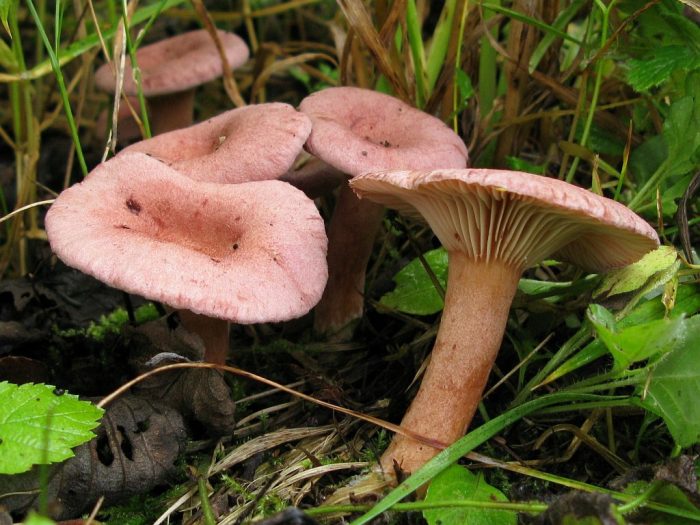
The average diameter of the lactic cap reaches 8 cm, but there are specimens with caps up to 30-40 cm in diameter. In young mushrooms, the edge of the cap adjoins the stem, gradually it straightens out to a flat, flat-concave or funnel-shaped shape. Sometimes a tubercle is expressed in the center. The edge is even, less often wavy. The color of the caps in different types of milkweed varies from white, gray, yellow, orange, brown to blue, purple, pink and even olive black. The color can also change with the age of the fungus. The surface of the cap is also variable: from smooth or velvety to scaly or pubescent.
Pulp
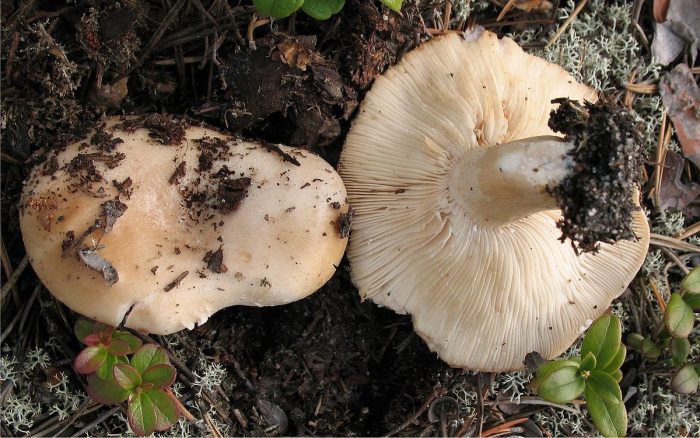
The fresh pulp of the lactarius has a pungent, pungent taste, or, on the contrary, fresh or slightly spicy, sometimes sweetish. The color of the flesh is usually white with a brown, gray, fawn or cream shade. The pulp changes color at cut and with age. Her smell is weak and vague, sometimes absent, specific only for certain species.
Leg
- Advertising -
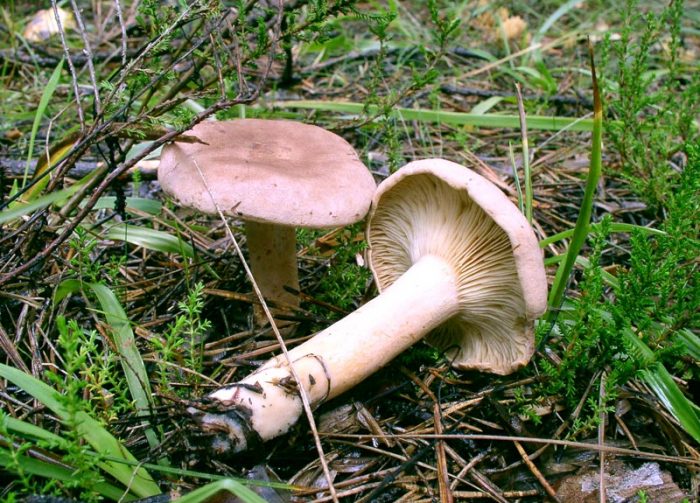
The leg is cylindrical, narrows or expands towards the base, the shape is club-shaped or swollen; the color matches the hat. Leg diameter 1.5-2 cm, height 5-8 cm. The surface is dry and smooth, sometimes sticky or slimy. Gradually, the leg becomes spongy and hollow.
Caesar mushroom. Where does the Caesar mushroom (royal mushroom) grow, its description and similar species
The edible Caesar or royal mushroom is described, the places of its distribution, the season of fruiting are given, similar species are listed.
The multifaceted mushroom community has its own aristocracy. Since the time of Ancient Rome, the fleshy yellow-orange representative of the amanita family has been called "royal mushroom" or "Caesar mushroom". They loved to serve it at elite antique feasts. However, this spectacular view does not give up its culinary positions to this day.
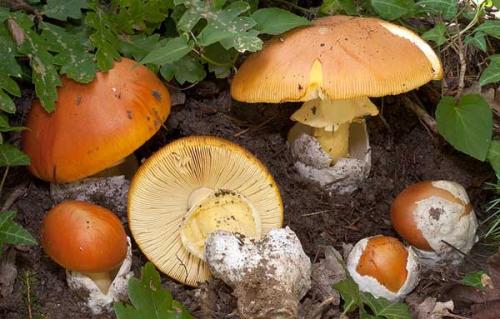
The Caesar mushroom (Amanita caesarea) is edible, has synonyms for the caesar's mushroom, the Caesar mushroom, the Caesar's mushroom, the Caesarean mushroom and the following species differences:
- the development of the fruiting body begins in an egg-shaped cocoon formed by a thick white veil;
- cap with dry skin, orange-yellow color. The color can vary from golden to bright red. The minimum diameter of the cap is 8 cm, the largest is 20 cm. As it develops, its shape changes from convex hemispherical to flat.Radial grooved edges. Flakes of white bedspread on the surface are usually completely absent;
- golden-yellow, often located soft plates do not grow to the stem. In the middle part they expand;
- spores are whitish;
- the leg is cylindrical; with a clavate base, covered by a wide, saccular, free volva, the width of which reaches 50 mm. The maximum size of the leg is 16 cm long, 3 cm thick. The color is orange-yellow, a hanging ring of the same color is clearly visible. There are weakly pronounced stripes above the ring;
- the fleshy flesh of the cap is yellowish under the skin. The flesh of the leg is pure white. There is no pronounced aroma and taste. Only very old, overripe specimens acquire an unpleasant smell of hydrogen sulfide.
Distribution and fruiting period
This fungus inhabits warm, dry areas of sandy soils in oak and chestnut groves. It occurs quite often, grows in groups, prefers the southern regions of the European forest belt, it is noted even in the subtropics. In warm climates, fruiting bodies ripen in autumn.

Similar species
The Caesar mushroom has dangerous poisonous counterparts, and the similarity with them is characteristic of different stages of development.
While the growing fruit body is in a light egg-shaped shell, it is difficult to distinguish it from the deadly one in a similar cocoon (Amanita phalloides). Everything is decided by the cut - even inside the veil, all parts of the Caesar mushroom, especially the cap, are painted golden yellow. A young pale grebe, as it should be, has only a yellow-greenish tint.
Grown up Caesar mushrooms sometimes acquire not just orange, but a bright red color and become similar to poisonous red fly agarics (Amanita muscaria). You can confidently distinguish them by carefully examining the cap and leg. The red fly agaric is most often covered with white flakes; a short ring-shaped volva grows to the base of the stem. In the Caesar mushroom, the cap is smooth, without flakes or with single white scales, and a wide free volva covers the bottom of the leg in a spacious bag.
The royal mushroom also has an edible double, a close relative with the same golden leg covered by a wide volva, but with a bright scarlet cap - the Far Eastern Caesar mushroom (Amanita caesareoides), which is often found in autumn deciduous groves in the south of Primorsky Territory.
Edibility
The taste qualities of the Caesar mushroom are sung in ancient poems - it was served to selected guests of ancient Roman gourmets. Fruit bodies of this type are prepared without preliminary processing - they are baked, fried and dried. At the "egg" stage, they are crushed into salads raw. However, in order to freely use the royal mushrooms for the preparation of tasty dishes, it is necessary to reliably distinguish them from their poisonous relatives.
"Tsar" hats of pure gold color often appear in velvet autumn in the southern regions of the forest zone. Experienced mushroom pickers have every chance to collect a rich "Caesar" harvest and join the culinary delights of ancient authors
At the same time, it is vitally important to know well the specific characteristics of royal mushrooms, which have a dangerous resemblance to toxic fly agaric
Where and when do milky mushrooms grow?
Mushrooms of the milky genus grow all over the world, meeting on the following continents: Eurasia, Africa, Australia, North America, South America. But they are especially abundant in the temperate zone of the Northern Hemisphere. Here the lactariuses form fruiting bodies in the summer in June-July. If the summer is dry, then "fruiting" is postponed to August-September. Since most of the species are cold-resistant and moisture-loving, they can bear fruit especially abundantly in autumn. But the lactarii do not grow for long, forming only 2 layers of fruit chalk.
Mushrooms of this genus live in symbiosis with many species of deciduous (usually birch) and coniferous trees. Brown milky (lat.Lactarius lignyotus) forms mycorrhiza with spruce, white milky (lat.Lactarius musteus) - with pine, brownish milky (lat.Lactarius fuliginosus) - with oak and beech, faded milky (lat.Lactarius vietus) - with birch ...
Mushrooms grow, as a rule, in damp places of the forest or on its edges, but they are also found in parks, in meadows, where there are tree roots. They often settle in the soil, sometimes on rotten wood or moss. The temperature favorable for their development ranges from 10-20 ° С. Fruit bodies live for 10-15 days, after which they rot. More often, milkmen grow in groups, some of them can form "witch's rings", for example, mushrooms and milk mushrooms.
The miller is gray-pink.
Millers are faded and brownish
The faded milky is a conditionally edible lamellar mushroom, in some reference books referred to as a marsh wave or a sluggish milky. Grows in small groups or in numerous colonies from the second half of August to the end of September, invariably giving large yields. Yields usually peak in September. Favorite habitats are areas of mixed or deciduous forests covered with a thick layer of moss, as well as wet areas of soil near swamps.
The cap of the mushroom is convex, with curved edges, but gradually it becomes prostrate-depressed, with a slight bulge in the middle and wavy edges. Its diameter is about 8 cm. The surface of the cap is smooth, damp, after rain it is covered with a thin layer of mucus sticky to the touch. It is painted in a grayish or brownish-lilac color, which in dry and hot summers fade almost to white.
Depending on the habitat, a poorly distinguishable pattern from concentric zones may appear on the surface of the cap in mature mushrooms. The plates are frequent, descending to the pedicle, at first cream, and then yellow. The leg is rounded, sometimes slightly flattened, straight or curved, at the base it can be thinner or thicker, hollow inside, about 8 cm high with a diameter rarely exceeding 0.5 cm.Its surface is smooth, moist, of the same color as hat, only slightly lighter. The pulp is thin, brittle, painted in a grayish color, practically odorless, but with a bitter taste. It produces a pungent milky sap, which, on contact with air, changes its white color to olive gray.
The faded milky belongs to the third category of mushrooms. Perfect for pickling, but requires pretreatment that removes bitterness from the pulp.
The brown miller is an edible lamellar mushroom that grows from mid-July to early October. You need to look for it in dense grass, on soils overgrown with moss, as well as at the foot of birch and oak in deciduous, broad-leaved or mixed forests.
The convex cap of young mushrooms eventually becomes at first prostrate, with a slight bulge in the middle, and then funnel-shaped, with a thin wavy edge. Its diameter in mature mushrooms is about 10 cm. The surface of the cap is smooth, dry, velvety, brown or gray-brown, darker in the center. In dry and hot summers, pale spots may appear on the cap or it will completely fade, becoming dirty yellow. Spore-bearing plates are narrow, adherent, white, which gradually changes to yellow.
The stem is rounded, thicker at the base, hollow inside, about 6 cm high and about 1 cm in diameter. Its surface is smooth, dry, of the same color as the cap. The pulp is soft, firm at first, and then loose, cream-colored, which, on contact with air, acquires a pink tint. It produces a white milky juice, pungent, but not bitter in taste, which quickly turns red in the air.
Brownish milky belongs to the second category of mushrooms, has good taste. It can be eaten without preliminary soaking and boiling. In cooking, it is used to prepare all kinds of dishes and for salting.
Definitioner
- Basidia (Basidia)
-
Lat. Basidia. A specialized structure of sexual reproduction in fungi, inherent only in Basidiomycetes. Basidia are terminal (end) elements of hyphae of various shapes and sizes, on which spores develop exogenously (outside).
Basidia are diverse in structure and method of attachment to hyphae.
According to the position relative to the axis of the hypha, to which they are attached, three types of basidia are distinguished:
Apical basidia are formed from the terminal cell of the hypha and are located parallel to its axis.
Pleurobasidia are formed from lateral processes and are located perpendicular to the axis of the hypha, which continues to grow and can form new processes with basidia.
Subasidia are formed from a lateral process, turned perpendicular to the axis of the hypha, which, after the formation of one basidium, stops its growth.
Based on morphology:
Holobasidia - unicellular basidia, not divided by septa (see Fig. A, D.).
Phragmobasidia are divided by transverse or vertical septa, usually into four cells (see Fig. B, C).
By type of development:
Heterobasidia consists of two parts - hypobasidia and epibasidia developing from it, with or without partitions (see Fig. C, B) (see Fig. D).
Homobasidia is not divided into hypo- and epibasidia and in all cases is considered holobasidia (Fig. A).
Basidia is the place of karyogamy, meiosis and the formation of basidiospores. Homobasidia, as a rule, is not functionally divided, and meiosis follows karyogamy in it. However, basidia can be divided into probasidia - the site of karyogamy and metabasidia - the site of meiosis. Probasidium is often a dormant spore, for example in rust fungi. In such cases, probazidia grows with metabasidia, in which meiosis occurs and on which basidiospores are formed (see Fig. E).

See Karyogamy, Meiosis, Gifa.
- Pileipellis
-
Lat. Pileipellis, skin - differentiated surface layer of the cap of agaricoid basidiomycetes. The structure of the skin in most cases differs from the inner flesh of the cap and may have a different structure. The structural features of pileipellis are often used as diagnostic features in descriptions of fungi species.
According to their structure, they are divided into four main types: cutis, trichoderma, hymeniderma and epithelium.
See Agaricoid fungi, Basidiomycete, Cutis, Trichoderma, Gimeniderm, Epithelium.
- Anastomoses (Anastomosis)
-
1) Fusion of cells of branched hyphae or germ tubes of germinating spores;
2) Connecting the plates of the fruiting bodies of the mushrooms with jumpers.
Mushroom common lactarius and its photo
Category: conditionally edible.
Lactarius trivialis cap (diameter 5-22 cm): shiny even in dry weather, with dark rings. Changes color and shape depending on the age of the fungus: in young mushrooms, it is dark and gray-gray, rather convex; in old ones, purple and brown, and then ocher or yellow, flatter and even depressed. Dense, maybe with small dimples. The edges are wavy, curved, often curled inward.
Stem (height 4-10 cm): pale gray or light ocher, cylindrical, sometimes swollen, but always hollow. A bit slimy and sticky.
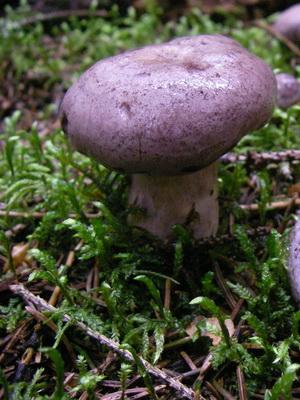
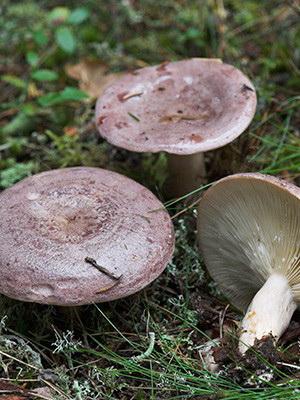
Pay attention to the photo of an ordinary milkman: its plates are frequent, thin (occasionally wide), mostly yellow or cream in color, with rusty spots. Pulp: thick and fragile
Mostly white, but brownish under the skin itself, and red at the base. Milky sap is very bitter; when interacting with air, it changes color to yellow or slightly greenish. Has a peculiar smell reminiscent of fishy
Flesh: thick and fragile. Mostly white, but brownish under the skin itself, and red at the base. Milky sap is very bitter; when interacting with air, it changes color to yellow or slightly greenish. Has a peculiar smell reminiscent of fishy.
Doubles: none.
When it grows: from mid-July to late September.
Where to find it: In humid places and lowlands of all types of forests, most often near pines, spruces and birches. Hides in dense grass or moss. An ordinary milkman is not afraid of pests.
Eating: fresh or salted, subject to pre-soaking to remove bitterness. When cooking, it changes color to bright yellow or orange.It is very popular in preparations for housewives in Finland.
Application in traditional medicine: not applicable.
Other names: gladysh, alder, nest, yellow nest, gray lump.
Faded milky: photo and application
Category: conditionally edible.
Faded lactarius cap (Lactarius vietus) (diameter 4-9 cm): gray, lilac, lilac or gray-brown, eventually fades to white or grayish. Slightly convex or outstretched. The center is slightly depressed, but with a slight tubercle and usually darker than the edges, which are curved towards the inner side. The surface is often uneven. Sticky and damp to the touch, with sticky twigs or leaves.


As you can see in the photo, the faded lactarius has an even, sometimes slightly curved leg. Its height is 5-9 cm. The color is white or light brown, lighter than the cap. The shape is cylindrical.
Plates: thin, narrow and very frequent. Cream or ocher in color, gray at the point of depression.
Flesh: white or gray, with a pungent milky juice. Thin, very fragile.
Doubles: none.
When it grows: from mid-August to early October.
Where to find: in deciduous and mixed forests, especially near birches. Prefers damp and swampy places.
The use of faded lactarius in cooking is limited - since the flesh of the mushroom is very thin, it is not very popular. Only the largest specimens are salted and pickled.
Application in traditional medicine: not applicable.
Other names: sluggish milky, marsh wave.
Growing a lactarius at home
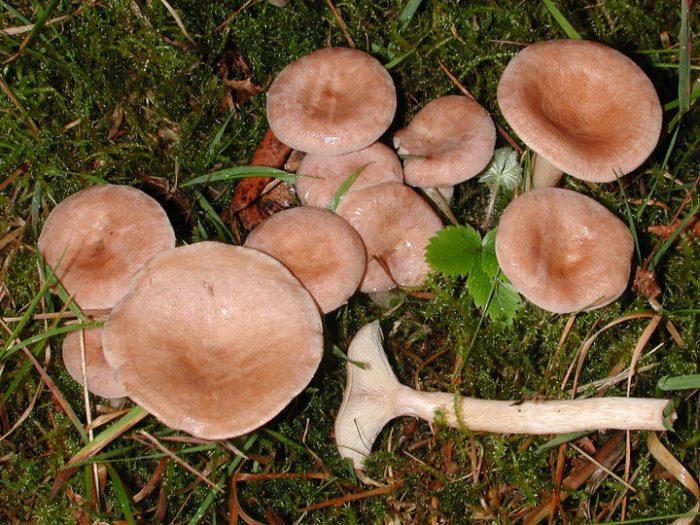
Millers breed either by buying ready-made mycelium, or by growing it from spores of a wild, mature mushroom. The mycelium is sown from May to September. In winter, it is planted in heated greenhouses. In the greenhouse, the mycelium of the lactarius is planted in a polyethylene bag filled with a substrate with slots through which mushrooms will germinate. The mycelium develops within 5 years.
The site for planting mycelium is well fertilized with peat. Deciduous trees up to 4 years old should grow on its territory.
The purchased mycelium is sown into a prepared substrate from a mixture of disinfected soil with sawdust of deciduous wood. Moss, fallen leaves, husks or straw are also added.
The soil at the planting site is pre-disinfected with a solution of lime (50 g per 10 l of water), spilling holes under the tree with a solution.
The wells are half filled with the substrate. Pieces of the mycelium of the lactarius are laid out on top, and completely filled with the substrate. The soil is tamped, pieces of moss and fallen leaves are spread on top.
In dry times, the site is watered with at least 30 liters of water per week. On hot days, it is sheltered from overheating. For the winter, they are insulated with fallen leaves.
The crop appears from July to August.
Harm and contraindications of milkmen
You must not pick and eat mushrooms that grow near highways, garbage cans and enterprises that pollute nature. The fact is that any mushrooms absorb harmful substances and heavy metals. Accordingly, they can be harmful to health.
Conditionally edible milkmen cannot be eaten without preliminary processing - soaking, boiling
This is done to remove the bitter milky juice, which, if it enters the human digestive system, can cause eating disorders.
All mushrooms should be eaten in small quantities, and for diseases such as pancreatitis, stomach and duodenal ulcers, gastritis, liver failure, cirrhosis of the liver, hepatitis, they should be abandoned altogether.
Lacticians are eaten with caution during pregnancy and lactation. Mushrooms are contraindicated for small children.
Salted mushrooms should not be eaten with hypertension and kidney disease, as this threatens to disrupt the water-salt balance.
The gingerbreads are real.




